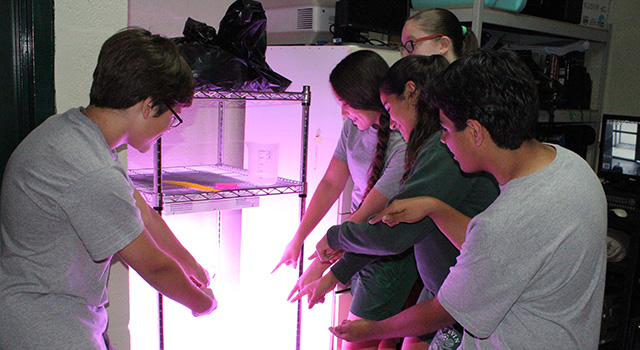By Cristina Cabrera Jarro -
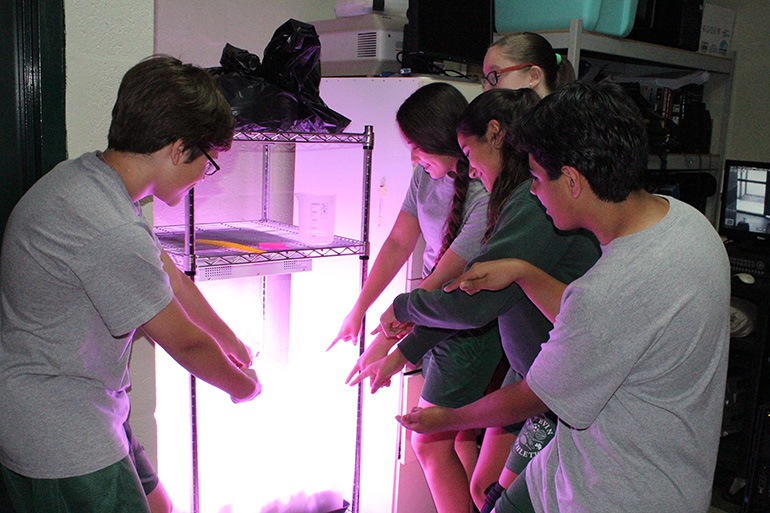
Photographer: CRISTINA CABRERA JARRO| FC
Oct. 28, 2015 MIAMI What's that spooky glow? Beneath the purple LEDs, edible leafy vegetables have been growing for over four weeks. St. Kevin School students accepted the NASA Fairchild Challenge called Citizen Science: Growing Beyond Earth. Standing by their space garden (from left to right) are Ryan Yglesias, Christine Rubido, Amanda Varela, Bella Dieguez and Joel Cruz.
MIAMI | St. Kevin School has set its sights on Mars — and its students are hoping to get there seed by seed.
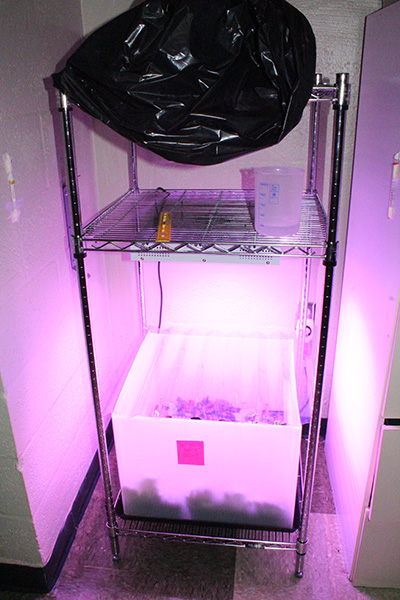
Photographer: CRISTINA CABRERA JARRO| FC
It may look like the lights at a nightclub, but according to NASA the purple LED lights are ideal for plant growth. The St. Kevin School space garden is part of the NASA Fairchild Challenge called Citizen Science: Growing Beyond Earth.
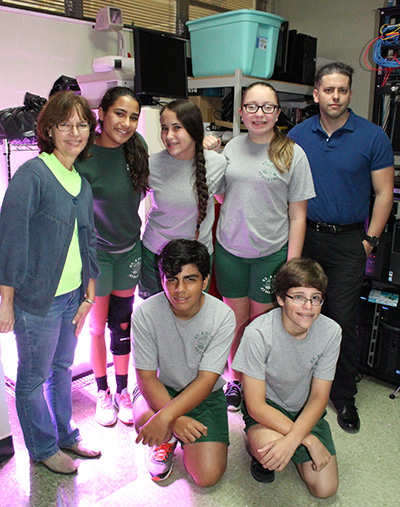
Photographer: CRISTINA CABRERA JARRO| FC
With good mentoring and teaching from St. Kevin School science teacher Olga De Novi (standing far left) and English teacher Alcides Martinez (standing far right), these kids will one day make it to the moon and beyond. St. Kevin School's Citizen Science: Growing Beyond Earth team members include (standing left to right) Bella Dieguez, Christine Rubido, Amanda Varela; (squatting left to right) Joel Cruz and Ryan Yglesias.
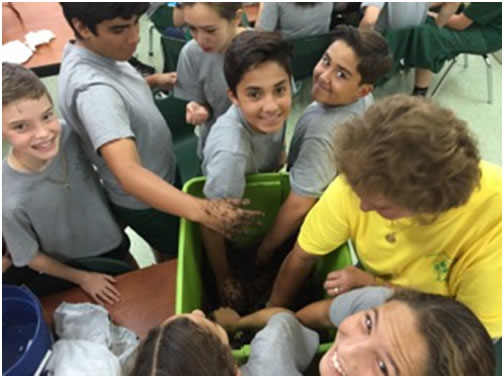
Photographer: COURTESY PHOTO
Middle schoolers from St. Kevin School get their hands really dirty in preparing the soil mix for their space garden with the aid of school Principal Mayra Constantino (right, in yellow). St. Kevin School accepted the NASA Fairchild Challenge called Citizen Science: Growing Beyond Earth.
As NASA prepares for a manned voyage to the red planet, it’s conducting experiments aboard the International Space Station. One of those involves creating a small “space garden” called Veggie, which is capable of growing vegetables, herbs and flowers in space. So far, two batches of edible veggies have been grown.
Now NASA has teamed up with Fairchild Tropical Botanic Garden and its annual Fairchild Challenge to invite 124 middle and high schools to take part in “Citizen Science: Growing Beyond Earth” and grow a “space garden” of their own.
St. Kevin was one of the schools that accepted the NASA-Fairchild challenge.
“I think it’s amazing that we’re able to do this,” said Bella Dieguez, an eighth grader at the school, noting that “we’re young,” and the students don’t typically grow their own plants.
“It’s interesting with all of the variables of space, and the problems, and the radioactivity, and will it grow, and will it supply the nutrition. It’s definitely interesting to figure out,” Bella said.
For five weeks, with the assistance of St. Kevin’s middle school science teacher, Olga De Novi, middle school English teacher Alcides Martinez, and other faculty members, students have grown leafy vegetables such as red romaine lettuce, Chinese cabbage and upland cress, in conditions similar to those in the International Space Station.
The space garden grows from a total of 25 four-inch pots placed on a tray on a rack with a protective outer box and a transparent lid to absorb purple LED lighting. While the purple appears spooky, NASA’s Veggie experiments have demonstrated that red and blue wavelengths of light, which when mixed together appear purple, provide the best lighting for plant growth.
“It’s very fascinating because even if you’re not really that interested in science, you can still learn how the plants grow in a different environment,” said eighth grader Amanda Varela.
The project allows students to participate in an assortment of different tasks similar to those currently being undertaken by professionals. From project managers, to plant physiology scientists, to food nutrition scientists, engineers and public relations and outreach specialists: every student has a task to fulfill.
“You have to learn to work as a group instead of working by yourself, such as when you have to work in a field, professionally, you can’t work by yourself, you have to work as a team,” said eighth grader Christine Rubido.
Students not only watch their plants grow, they must also measure, research, analyze, collect data, make graphs, record and interpret their findings. The NASA-Fairchild challenge requires them to keep an online spreadsheet and Tweet updates on their plants’ growth (follow them on Twitter @StKevinSTKS).
“I think we’re making a major contribution to science,” said eighth grader Ryan Yglesias. “For kids our age doing something at the same level as NASA scientists, it’s a big deal.”
“It really teaches teamwork and it basically teaches the full scientific method,” he added.
While he and his classmates monitor their plants from this planet, they also are thinking light years ahead in terms of the next step: colonizing Mars. With a vast universe, the students imagine that there is plenty to explore and do in the “final frontier.”
“Everything that’s happening now is something that God planned for us,” said Amanda. “Mars, if he wants us to have a new environment, then he will make it happen.”
But before they grab their space suits and hop on a shuttle to the next galaxy, the team of eighth graders also ponders whether God might want mankind to simply stay on Earth and take care of this planet.
“If he wants us to stay in this perfect planet, then we’ll stay on this perfect planet and we’ll figure it out,” said Christine.
Still, the students marvel at the possibilities of one day travelling from planet to planet. However, they believe it will be possible only when mankind unites across cultures, race, gender and religion.
Eighth grader Joel Cruz cited the novel-turned film “The Martian” as a prime example: “People from all over the world were watching this one guy stuck on one planet and it’s amazing how the world came together for once and worked together to save just one person. And I think not only from a scientific point of view but from a religious point of view that’s a great thing: to unite the world for one objective.”
